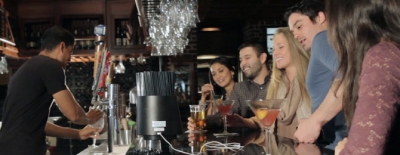The importance of a first impression is considered by most to be an unquestioned truism. Scientists, Psychologists and even the mainstream media repeatedly communicate the significance of the first moments of any initial encounter. In a short time, conclusions are drawn by each party about the other that can be difficult if not impossible to change. The same phenomenon occurs when a customer has initial contact with your bar. Knowing why this happens and what your customer is looking for gives you a great chance to make their initial impression a positive one. Knowing what else they are looking for allows you to validate a positive initial impression and deliver an exceptionally satisfying guest experience.
The Primacy Effect
Why are initial impressions so important and so lasting and how come they can be so hard to reverse? The answer lies in the phenomenon known in psychology as the primacy effect. In essence it postulates that information gathered at the beginning of any encounter is easiest to recall and therefore has greater influence on overall impression. You can spend all night engaging a customer at your bar and making the hell out of her drinks. If she encountered a rude doorman or inattentive host upon arriving, your efforts are unlikely to alter her overall impression of her experience and your establishment. That doesn’t seem right. The core product and service she came in to consume were delivered with great skill and to great effect. But it’s right -- she’s not happy.
In such a case your solution to falling short could center around engaging in some form of service recovery – providing some appropriate combination of apologies and product to make up for the failure. That is probably best in the short term. In the long term however, the best course of action is to fix the problem with the initial encounter. Here’s how.
The Guest Experience
The success of any guest experience is determined by the guest. This fact can make satisfying them seem impossible, but it’s not. The guest experience consists of three components – product, setting and delivery. Product refers to the package of goods and services you offer. The setting is the space within which goods and services are experienced. Delivery refers to the people and systems in place to get the service package from the establishment to the guest.
It’s important that excellence be maintained throughout this framework of experience. It is especially important that the guest’s initial connection to each of these components, and therefore his initial impression of each, be positive. Here’s what he expects you to deliver.
1. A pleasant and immediate initial greeting. Regardless of how busy or popular you are, your customers have chosen to take their business to you instead of one of your many competitors. They expect you to act like you appreciate it.
2. An attractive, appropriate and clean environment. Loud and chaotic is great if that’s who you are. Peanuts on the floor are great if that’s who you are. A dirty bar covered with empty glasses is unacceptable no matter who you are.
3. Reasonable wait times. The perception of the reasonableness of wait times is directly related to expectation. No matter what, always promise a longer wait than you expect to deliver. A five minute stated wait time that turns into ten minutes results in an initial negative impression. A fifteen minute stated wait time that turns out to actually be ten minutes exceeds expectation and results in an initial positive impression.
4. Engaged wait times. The perception of the duration of wait times is directly related to engagement. Keeping your customers busy while they wait can make that wait feel shorter to them. Televisions as well as other media can accomplish this trick. You can drop off the specialty cocktail menu to new arrivals at your bar while you take care of other customers.
5. Fair and equitable service. Pay particular attention to the order that customers arrive at your bar and serve them in that order. We love to receive special treatment but hate it when others get it at our expense.
Everything Else
It has mostly been my experience that hospitality professionals are aware of the importance of first impressions if not always sure which ones are most important or exactly how to deliver positive ones. Hopefully some of that got taken care of above.
It has also been my experience that most of us are not at all aware of the importance of final impressions and so do a really bad job at the end. Some experts argue that they are as important, if not more important, than initial impressions. They base their opinion on the recency effect, the concept that what we remember most is what we most recently experienced. That being the case, these experts would argue that the end of any service encounter is therefore most responsible for a guest’s overall impressions and ultimate satisfaction.
I think that the beginning, middle and end of a service encounter are all important and all have a significant impact on overall guest satisfaction. The reason that first and last guest impressions can be problematic has a lot to do with the disconnect between what we think our job is and what our customers think it is. We focus on delivering what is most difficult for us to deliver – the middle. Taking orders, making drinks, delivering food and beverage, being fast and accurate all require significant skill, effort and acumen and so there is where we focus. We might wrongly ignore new customers or customers looking to cash out a tab in favor of mixing a large order of cocktails for a table in the dining room. Though it seems counterintuitive, waiting a few seconds to make those drinks to say hello and welcome or goodbye and thank you is the much more effective way to deliver the experience your customers crave.
thanks to original post:http://www.nightclub.com/bar-management/guest-service/the-importance-fir...
















